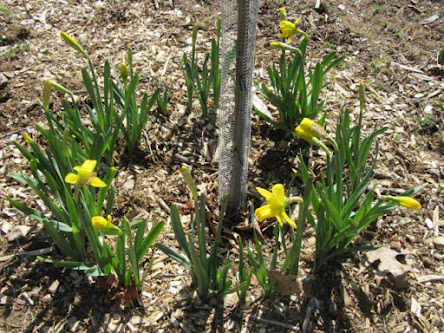Companion planting for disease resistant and increase harvest
A fruit tree guild is a technique of supporting a central element (fruit tree) with a group of plants that are highly useful and multifunctional, with mutual beneficial synergies to ensure a disease-resistant fruit tree with maximum harvest and use of space. Guilds provide a roadmap for developing interconnected ecosystems to reduce labor, cost and increase harvest. This companion planting is a holistic approach and an integral part of permaculture which allows 2 or more crops to be planted together in order to maximize productivity (yield per unit area), nutrients intake, support, space usage, pest control, pollination, biodiversity or attract beneficial insects and/or organisms. Companion planting is a traditional practical planting method covering various strategies that increase plants' biodiversity in the soil and the ecosystem. Plants diversity increases insect diversity and decreases the number of pest in the farm. Most large scale farmers practice a single crops planting system called mono-cropping. This may looks easier to water and care for, but it will need lots of chemicals to control the pests. For example, if you plant only tomatoes, hornworms will be attracted to the farm. But if you plant lettuce along with tomatoes, the tomatoes will provide shade to the lettuce while the lettuce will repel the tomato pests. Bingo!!!
 |
| Daffodils as companion plant for fruit tree |
Pollination is a very essential element for fruit formation. All fruits trees should have some pollinator plants growing close to the fruit trees such as flowers and herbs that attract insects to aid pollination. An increase in pollination results to an increase in fruits harvest. Below is a list of some of our favorite companion plants for fruit trees/plants:
1. Nitrogen fixing plants such as groundnuts, beans, cowpeas and soya beans are beneficial to all fruits plants/trees because they fertilizes the soil and could be planted close to any fruits tree/plant.
2. Comfrey is also a wonderful companion to fruits trees/plants because it accumulates calcium, phosphorous and potassium that fertilize plants/trees. It is also a good compost activator.
3. Chive repels worms, flies, aphids, mites and nematodes.
4. Lemon balm is a great companion plants because it draws bees that help with pollination and consequently increase yield of fruits.
5. Stinging nettle sprays are rich in silica and calcium that is use to stimulate growth in plants/trees.
6. Mint and marigold are very good to repel undesirable pests. Plant at the edge where you can control it as it can become invasive.
7. Marjoram is easy to grow and helps to improve the flavor of many fruits.
8. Lemon grass is good as a border crop to frame vegetables and herbs.
9. Alfalfa improves nitrogen, iron, magnesium, phosphorous and potassium which are beneficial to enrich soils around fruit trees/plants.
10. Red acalypha and Tithonia plants repel nematodes commonly known as 'panama' in plantains/banana.
11. Basil improves fruits flavor and repels bugs especially mosquitoes.
12. Pumpkin keeps away harmful pest.
13. Daffodil or garlic repels wildlife and fruit tree borer.
14. White clover is a good source of nitrogen which is essential for healthy fruit production.
15. Calendula is useful in repelling undesirable insect, but attract beneficial ones. It also protects and enrich soil nutrients.
- Avocado (African pear):- Soya beans, cowpeas, groundnuts, comfrey
- Banana or Plantains:- Beans, legumes, papaya, sweet potatoes, legumes, comfrey, flowers.
Avoid cassava competition for potassium - Citrus e.g orange, tangerine, lemon: - Beans, basil, oregano, clover, peas.
Avoid maize, sweet potatoes, cowpea, sorghum - Papaya (pawpaw):- Comfrey, beans, flowers, banana sweet potatoes
- Passion fruits: - Irish potatoes, beets, carrots, spinach, strawberries, onions, leeks, lettuce.
Avoid corn, sorghum, okro, cowpea - Melon:- Corn, pumpkin, oregano.
Avoid peas and beans - Apples:- Garlic, leeks, marigold, comfrey, daffodils.
Avoid tomatoes, carrots, potatoes, eggplant - Mangoes:- Marigold, comfrey, lemon balm, dandelions, daffodils.
Avoid fungal prune plants - African butter (Plums):- Marigold, comfrey, lemon balm, dandelions, daffodils
- Grapes:- Basil, beans, oregano, clover, peas.
Avoid garlic and cabbage - Pomegranate:- Basil, thyme and flowers.
Avoid fennel, celery, eggplant - Apricot:- Chives, garlic, leeks, comfrey, basil, daffodils.
Avoid pepper, tomatoes, potatoes, eggplant - Coffee / cocoa:- Potatoes, kale, beans, coconuts.
Avoid pumpkin, carrots, cucumber - Kolanut / Guava:- Beans, peas, marigold
- Kiwi:- Carrots, spinach.
Avoid eggplant - Figs:- Dandelions, marigold, lemon balm.
Avoid eggplant - Pineapples:- Daffodils, clover, chives, garlic
- Tea:- Beans, potatoes, peas.
Avoid walnut
 |
| Typical fruit tree guild |
Follow this links to learn more about improving the biodiversity of your farm, reducing maintenance, and increasing yield through permaculture. If you wish to live the change, then click here
Learn more about pollinators here
Remember to try your own experiments and share your experience with us. Create your own fruit tree guilds even in your garden or backyard and feedback. Let’s know what works for you. Let’s do it…!
1. Make a list of what you need in your own garden
2. List out all the elements you’ll need to meet the above needs.
3. Brainstorm the needs and benefits of each element, and note down how they can benefit from each other.
4. Place the elements in a way that maximize the beneficial relationships among them.
5. Share your experiences with us, we would love to hear from you.
Do you have any question about companion planting?
Write them out in the comment section, because I’d love to answer them below....
We shall be uploading videos soon on our YouTube channel. Subscribe to our channel, like, comment and hit on the notification button to keep up with update. Like our Facebook page and follow us on Instagram and Twitter


